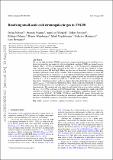| dc.contributor.author | Nelson, Dylan | |
| dc.contributor.author | Sharma, Prateek | |
| dc.contributor.author | Pillepich, Annalisa | |
| dc.contributor.author | Springel, Volker | |
| dc.contributor.author | Pakmor, Rüdiger | |
| dc.contributor.author | Weinberger, Rainer | |
| dc.contributor.author | Vogelsberger, Mark | |
| dc.contributor.author | Marinacci, Federico | |
| dc.contributor.author | Hernquist, Lars | |
| dc.date.accessioned | 2022-05-06T17:13:29Z | |
| dc.date.available | 2022-05-06T17:13:29Z | |
| dc.date.issued | 2020 | |
| dc.identifier.uri | https://hdl.handle.net/1721.1/142404 | |
| dc.description.abstract | © 2020 The Author(s) Published by Oxford University Press on behalf of the Royal Astronomical Society. We use the high-resolution TNG50 cosmological magnetohydrodynamical simulation to explore the properties and origin of cold circumgalactic medium (CGM) gas around massive galaxies (M 1011 M) at intermediate redshift (sim 0.5). We discover a significant abundance of small-scale, cold gas structure in the CGM of 'red and dead' elliptical systems, as traced by neutral H i and Mg ii. Halos can host tens of thousands of discrete absorbing cloudlets, with sizes of order a kpc or smaller. With a Lagrangian tracer analysis, we show that cold clouds form due to strong 1 gas density perturbations that stimulate thermal instability. These local overdensities trigger rapid cooling from the hot virialized background medium at ∼107 K to radiatively inefficient ∼104 K clouds, which act as cosmologically long-lived, 'stimulated cooling' seeds in a regime where the global halo does not satisfy the classic tcool/tff 10 criterion. Furthermore, these small clouds are dominated by magnetic rather than thermal pressure, with plasma 1, suggesting that magnetic fields may play an important role. The number and total mass of cold clouds both increase with resolution, and the mgas ≃ 8 × 104 M⊙ cell mass of TNG50 enables the ∼few hundred pc, small-scale CGM structure we observe to form. Finally, we make a preliminary comparison against observations from the COS-LRG, LRG-RDR, COS-Halos, and SDSS LRG surveys. We broadly find that our recent, high-resolution cosmological simulations produce sufficiently high covering fractions of extended, cold gas as observed to surround massive galaxies. | en_US |
| dc.language.iso | en | |
| dc.publisher | Oxford University Press (OUP) | en_US |
| dc.relation.isversionof | 10.1093/MNRAS/STAA2419 | en_US |
| dc.rights | Attribution-NonCommercial-ShareAlike 4.0 International | en_US |
| dc.rights.uri | https://creativecommons.org/licenses/by-nc-sa/4.0/ | en_US |
| dc.source | arXiv | en_US |
| dc.title | Resolving small-scale cold circumgalactic gas in TNG50 | en_US |
| dc.type | Article | en_US |
| dc.identifier.citation | Nelson, Dylan, Sharma, Prateek, Pillepich, Annalisa, Springel, Volker, Pakmor, Rüdiger et al. 2020. "Resolving small-scale cold circumgalactic gas in TNG50." Monthly Notices of the Royal Astronomical Society, 498 (2). | |
| dc.contributor.department | MIT Kavli Institute for Astrophysics and Space Research | |
| dc.relation.journal | Monthly Notices of the Royal Astronomical Society | en_US |
| dc.eprint.version | Author's final manuscript | en_US |
| dc.type.uri | http://purl.org/eprint/type/JournalArticle | en_US |
| eprint.status | http://purl.org/eprint/status/PeerReviewed | en_US |
| dc.date.updated | 2022-05-06T17:05:04Z | |
| dspace.orderedauthors | Nelson, D; Sharma, P; Pillepich, A; Springel, V; Pakmor, R; Weinberger, R; Vogelsberger, M; Marinacci, F; Hernquist, L | en_US |
| dspace.date.submission | 2022-05-06T17:05:16Z | |
| mit.journal.volume | 498 | en_US |
| mit.journal.issue | 2 | en_US |
| mit.license | OPEN_ACCESS_POLICY | |
| mit.metadata.status | Authority Work and Publication Information Needed | en_US |
